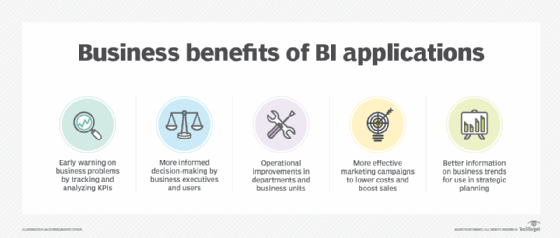How to build an effective business intelligence strategy
Explore the eight steps organizations need to develop and implement a successful business intelligence strategy, as well as some of the challenges staff can encounter.
Corporate executives continue to invest heavily in data and analytics initiatives. For example, the "2024 Data and AI Leadership Executive Survey" -- published in January 2024 by consulting firm Wavestone -- found that 87.9% of respondents reported investments in data and analytics as a top organizational priority.
Although many of those investment dollars now go to AI projects, business leaders said organizations continue to spend on conventional business intelligence. That spending is well-placed because BI is a critical discipline to understand the past, current and future state of an organization.
"Business intelligence is the process of collecting, processing and analyzing data to provide insights into the current state of an organization," said Sandy Estrada, vice president of analytics and information management at consulting firm Cervello, a Kearney company.
BI is critical for tracking an organization's progress against KPIs, as well as its financial and operational performance. This gives stakeholders a clear visual on how they, their departments and the organization are doing, said Kevin Tucker, advisory practice lead for data analytics, architecture and AI at Info-Tech Research Group.
BI also provides a picture into what's next, supplying insights into, for example, anticipated demand for products and expected sales, helping organizational leaders make smarter, data-driven decisions, Tucker said.
Even in the age of AI, the insights provided by an organization's business intelligence function, enabled by BI software, is critical.
"BI focuses on delivering reports, dashboards and analytics that allow decision-makers to evaluate business performance and identify trends," Estrada added. "It serves as the foundation for understanding operations, performance metrics and other key data-driven indicators."
Why is a well-planned BI strategy important?
Despite the importance of BI to the enterprise, not all organizations have a mature, strategic program. But they should, said Alicia Johnson, a consulting principal in technology transformation at professional services firm EY. A well-planned BI strategy helps ensure an organization maximizes its investment in this space and, more importantly, gains insights and decision-making support to improve business performance overall.
"An effective and well-planned BI strategy improves a client's ability to manage risks and allows predictive outcomes, providing better insights to everyone from stakeholders to investors," Johnson said.
Organizations that don't have such a strategy in place typically struggle to get value out of their data investments and business intelligence tools. Organizations without a good strategy also often have uneven results with their BI investments, with strong BI capabilities in some areas but little to no BI use in other parts of their business.
Such outcomes demonstrate the value of a BI strategy, Estrada said, noting that "a solid strategy gives companies the tools they need to really make the most of their data now and in the future."

8 key steps to create a business intelligence strategy
To develop and implement a successful business intelligence strategy, organizations should take the following steps.
1. Align the BI strategy to business goals and associated metrics
BI is designed to shed light on how the organization and its various components are performing so that enterprise leaders can identify opportunities, areas of improvement and best actions to take, said Sven Jost, a partner in the data analytics practice at accounting and consulting firm BPM. "BI plays a very important role in understanding your business, running your business and how you get to the next level," he said.
That's why the first component of an effective BI strategy is alignment with the organization's overall goals and objectives -- and the measurements that track progress toward reaching them.
"A good strategy starts with the business strategy and knowing the key metrics you want to look at," Jost explained. "Know what information you want to see on a daily, monthly or recurring basis. Know what information is relevant to decision-makers and other stakeholders."
2. Identify and prioritize BI use cases
Nearly every area of a typical enterprise can benefit from the use of BI tools to get a better grasp on how it's truly performing and how that performance stacks up against historical performance and current goals. BI can also help an enterprise benchmark itself or any functional area or process against others. And it can help organizations make better decisions and plan future actions.
Given the plethora of opportunities for BI uses, Jost said he advises organizations to identify potential use cases and then prioritize the deployment of BI capabilities to areas where gaining those insights can produce the biggest returns.
3. Build and execute a strong data strategy
A solid BI strategy needs to be paired with an equally strong data strategy, Tucker said, because BI needs more than data -- it needs the right type, quantity and quality to produce useful insights. Despite the importance of quality data for BI applications, many organizations have a lot of work to do to get the strong data program they need, Tucker said.
He said there are many reasons why organizations still struggle with data. For example, leaders might focus on developing a data program for the entire organization but fail to take a "fit-for-purpose approach" where they ensure the right data is available for each specific BI use case.
"You need to make sure data is pristine for the business use cases you're pursuing," Tucker said, adding that organizations need to ensure that pristine data can reach the BI tools when required by building the necessary data pipelines, data governance and data expertise.
4. Select the right BI tools
Equally important to getting the right data is getting the right tools, Tucker said.
As is the case with most software selections, enterprise leaders should evaluate BI vendors and products based on the following criteria:
- What they want to achieve with their BI tools and which vendors best support those goals.
- Integration requirements to ensure the software works in their IT environment.
- The user interface and overall usability of each option.
- Security and compliance features.
5. Create a BI team
An effective business intelligence strategy should outline the skills the organization needs to optimize the value of its BI program and develop plans to ensure it has the needed talent in the right places.
"Make sure your teams have the skills they need to grow and adapt as the business evolves," Estrada said. "Regular training and development will help your data teams stay effective and aligned with the company's goals."
Organizations need workers with data analytics skills and training in data visualization and on the particular BI tools. These workers are often BI analysts, although workers in other roles increasingly have these skills and are being tasked to work on BI projects, said Bipin Prabhakar, chair of the information systems graduate programs at Indiana University's Kelley School of Business in Bloomington.
An effective BI strategy also considers what IT workers, data professionals and business domain experts are needed to work with BI analysts to produce optimal results.
6. Adopt a BI governance framework
Organizations should adopt a governance framework to ensure a BI program delivers value and that stakeholders can trust the analyses produced by the BI tools, Tucker said.
Like other frameworks, a BI governance framework outlines the policies, procedures and rules that determine how BI use cases are identified, prioritized, secured, evaluated and monitored. A good framework also outlines how risks are identified, measured and mitigated.
7. Develop plans to scale and mature BI initiatives
Organizations should create a scalable BI operating model, Estrada said. "Set up a model that supports the ongoing use of data across the business," she said. "This means defining KPIs, ensuring the right tools and processes are in place, and creating a governance structure that promotes continuous improvement. Plus, it ensures that teams are continuously upskilled and able to grow with the business."
Organizations should also have a BI program roadmap to ensure their capabilities keep pace with advances, said Nick Kramer, vice president of applied solutions at global consulting firm SSA & Company.
Kramer said he advises organizations to apply Agile concepts to their use of BI, looking for opportunities to both incrementally and continuously mature how and where they're using business analytics -- for example, adding self-service BI capabilities or finding opportunities to automate pieces of the process.
8. Include plans to use AI and generative AI
Generative AI (GenAI) and other AI technologies are transforming business intelligence activities, said Zoey Jiang, assistant professor of business technologies at Carnegie Mellon University's Tepper School of Business in Pittsburgh.
For example, AI along with automation is transforming how data is collected, analyzed and presented, she said. More specifically, GenAI now helps BI analysts and others code queries. It also helps make sense of unstructured data for use in analysis, and it allows queries to be written in natural language.
Given the power of AI in this space, organizations should have strategies that account for the growing use of AI in business intelligence software so they can successfully use such advancements in their own BI programs.
Common challenges faced in building a BI strategy
When building a BI strategy, enterprise leaders often struggle to do the following:
- Identify and involve all stakeholders. They might loop in technical and data leaders but not include enough business users -- or vice versa. This leaves the strategy without a complete picture of what is needed to build a strong BI program.
- Align BI use cases to the organization's goals. If this isn't done, corporate executives, business managers and operational workers might get some information thanks to BI tools, but the applications won't provide insights in the areas most important to the success of the organization.
- Create a solid data strategy. This is a must to deliver the data quality levels required to generate accurate insights for business users.
- Design a universal and scalable BI strategy. The BI process must be strong across the enterprise and not just in pockets within an organization. Companies also need a strategy that can scale and evolve as technical capabilities, business needs and workforce skills change.
Mary K. Pratt is an award-winning freelance journalist with a focus on covering enterprise IT and cybersecurity management.








